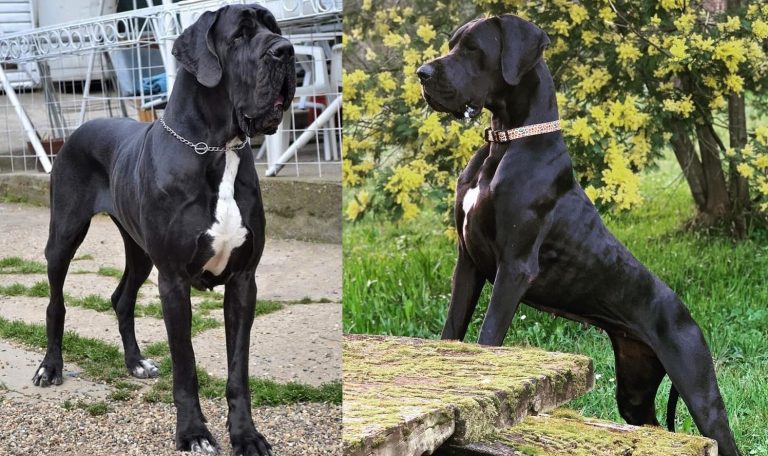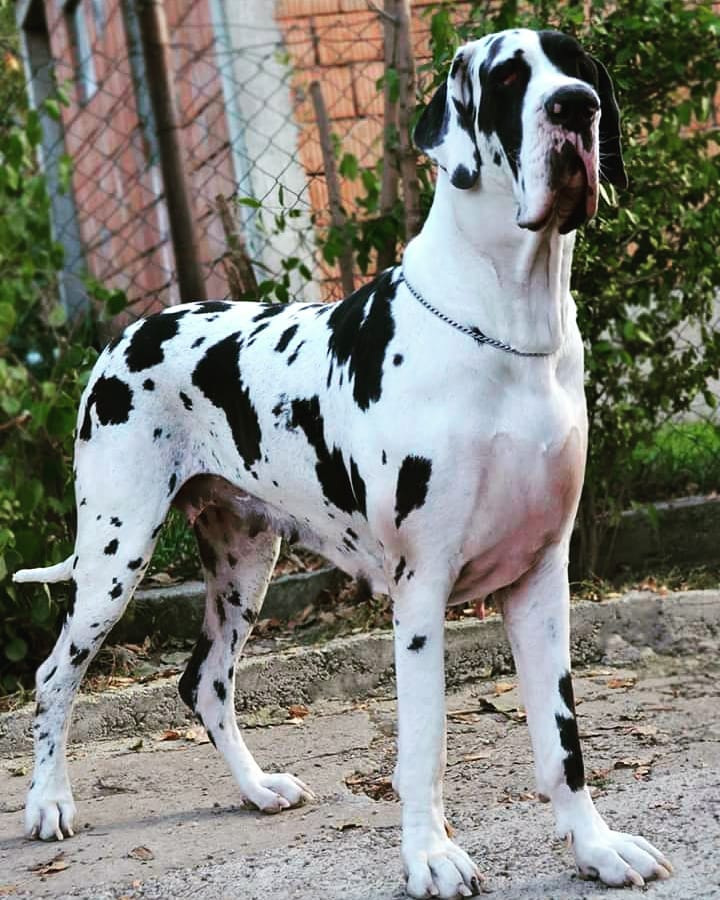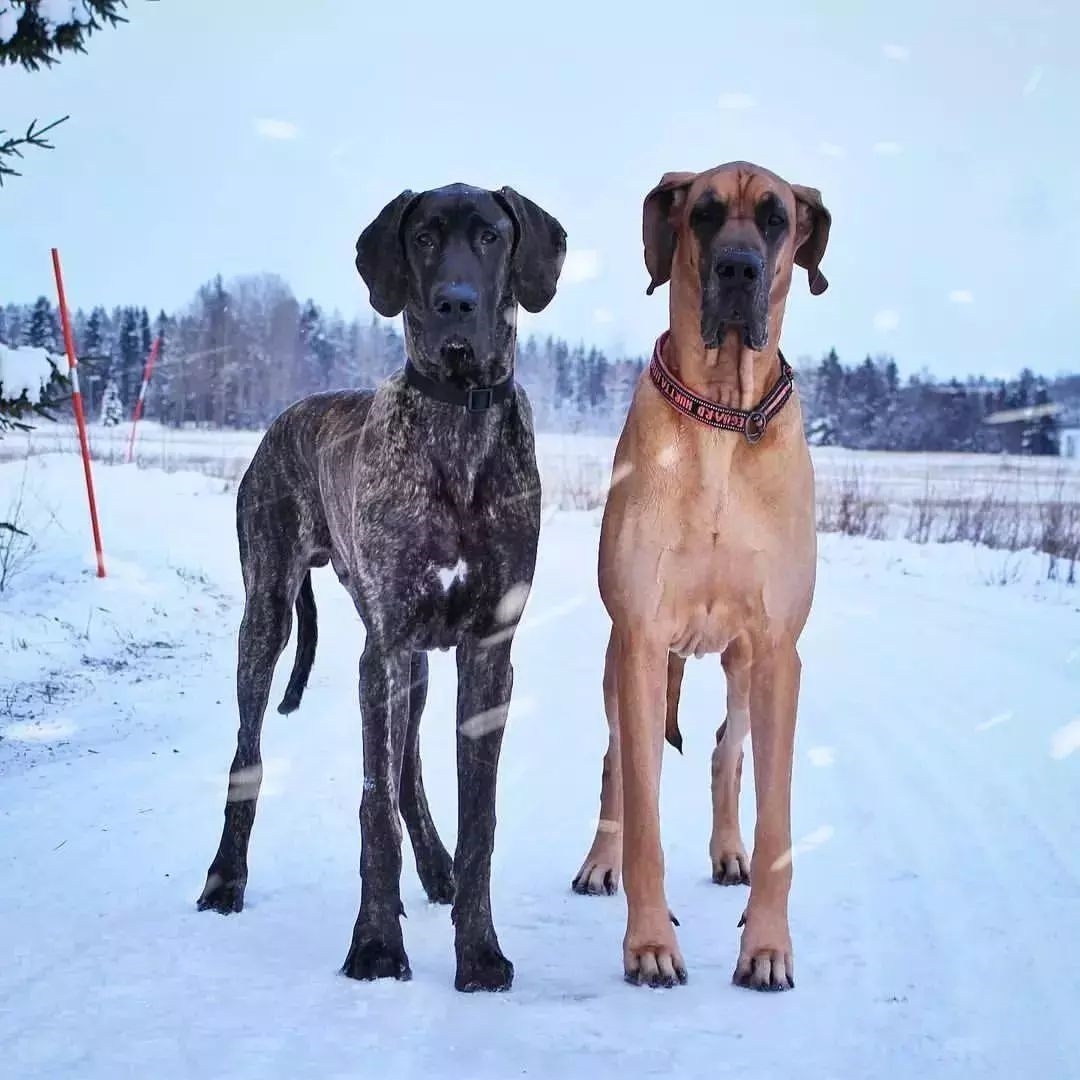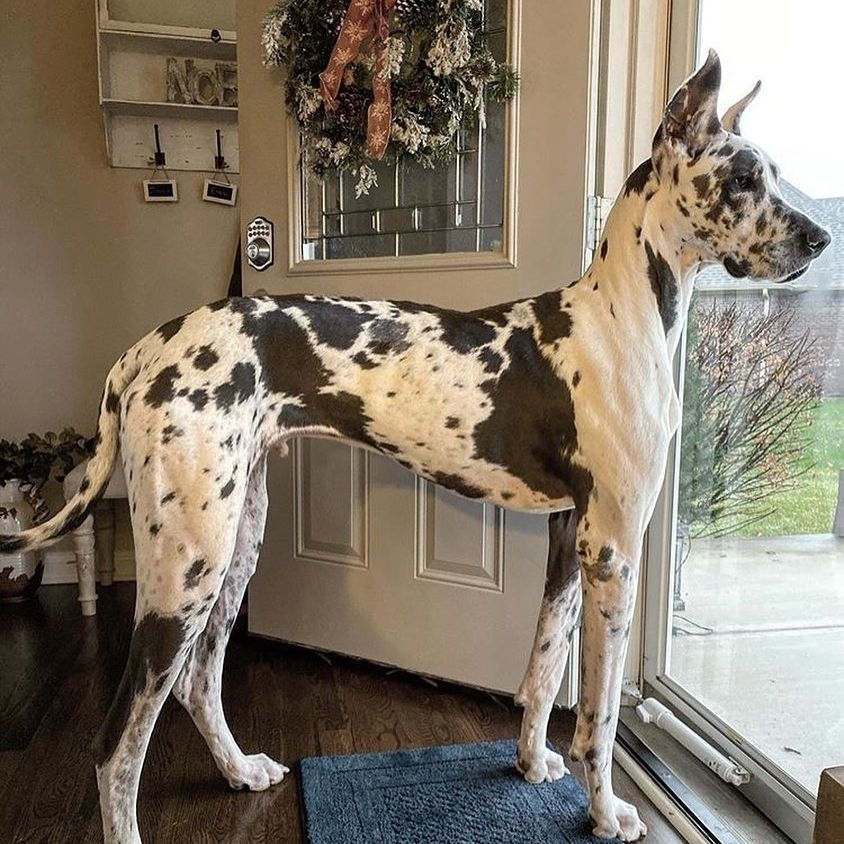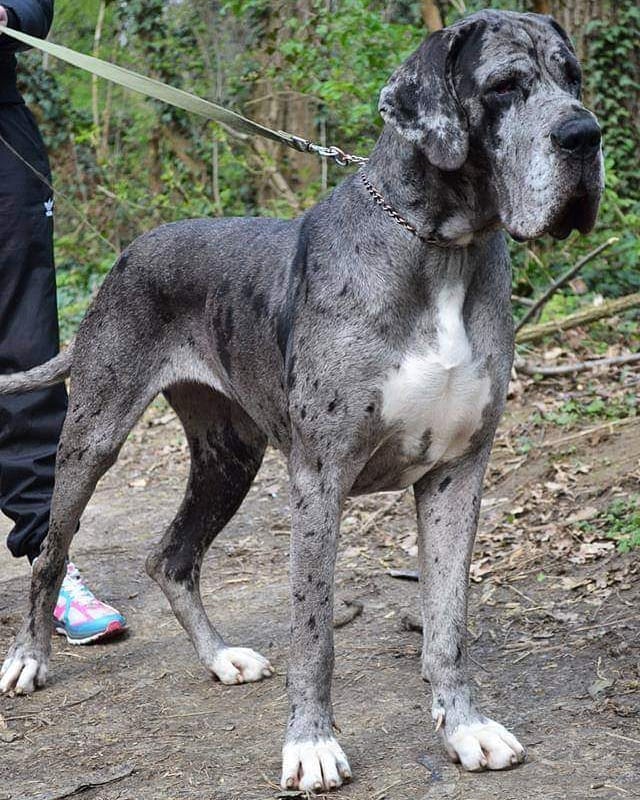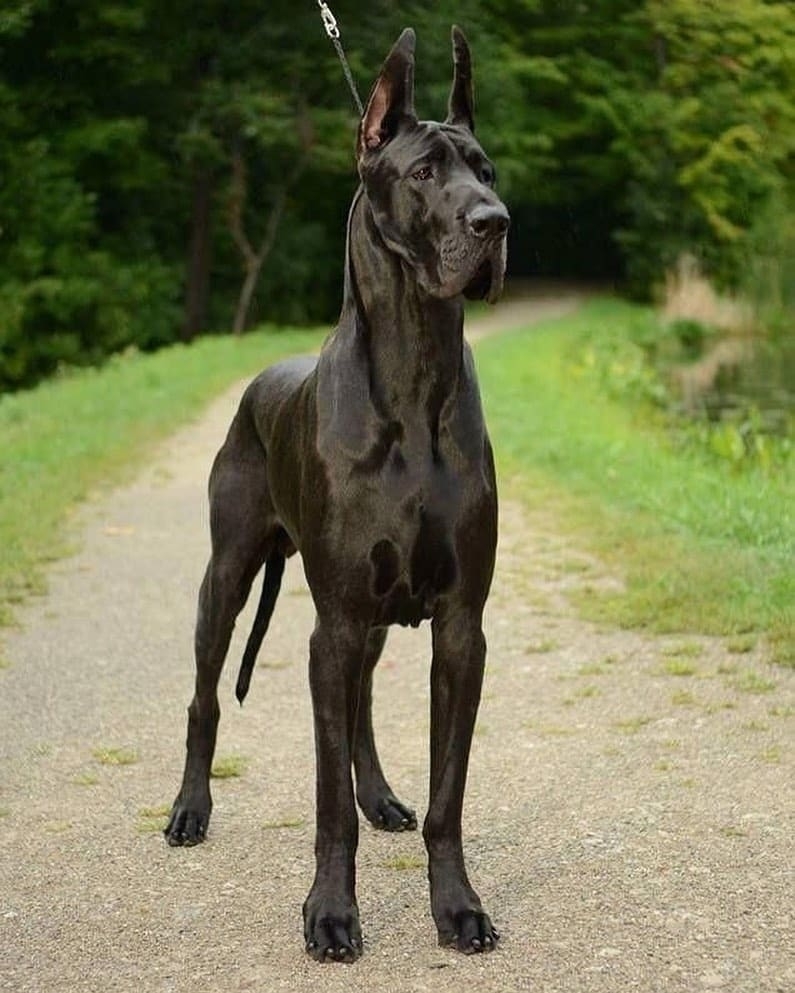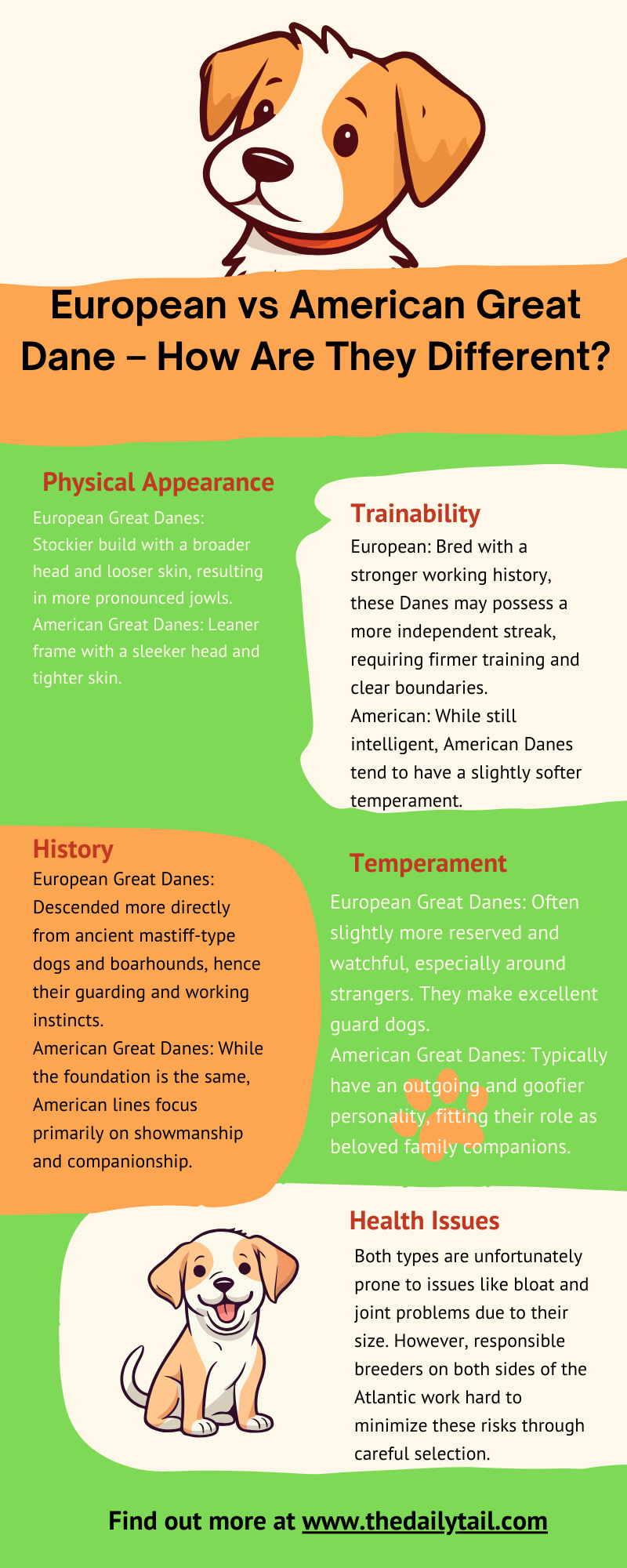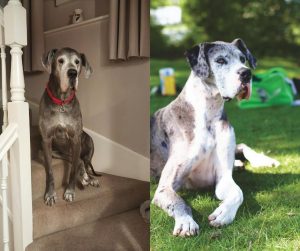I’ve always had a soft spot for Great Danes – those gentle giants of the dog world. But as I delved deeper into the breed, I realized there’s more to these majestic dogs than meets the eye. Did you know there are actually European and American Great Danes, each with its own distinct flavor?
The Great Dane originated in Europe. Yet, it has become a popular breed in the United States as well. The breed is so popular in the US, that some people have begun to make a difference between European vs American Great Dane.
But what is the story about it? Are these two different? How can you spot the differences? These two lineages began to diverge due to the breeding practices and preferences. While they share the same DNA, there are some differences.
Admired for their elegance, grandeur, and beauty, Great Danes are amazing dogs that you can bring to your household. Let’s examine the difference between the European Great Dane and its American counterpart.
Breed History
We have to begin with the breed history to get to the end. Nowadays, dogs recognized by The American Kennel Club are known as purebred. But what is interesting is that most purebred dogs nowadays are made by combining different dog breeds.
In the case of the Great Dane, that included the Mastiff, Greyhound, and Irish Wolfhound. Breeders took specific traits from each dog. They took the muscle mass from the Mastiff, the speed from the Greyhound, and the size of the Irish Wolfhound,
Breeding began in the 16th century, as the English breeders were looking for large and strong dogs. They crossed the English Mastiff with the Irish Wolfhound. Then, in the 17th century, those dogs were brought to Germany where the development continued.
The goal was to keep prey under control when hunting wild boars and bears. The dog was used to keep the prey under control under the hunter would come and kill it.
In the 19th century, traditional hunting of big game slowly went out of fashion. New firearms appeared, and large hunting dogs began to disappear.
Yet, because of its majestic appearance, the Great Dane continued to thrive. Breeders changed their approach, developing a friendly, gentle, and undemanding dog. The big misconception nowadays is that these dogs originate from Denmark. Instead, they are German dogs.
Initially, Germans had two types of the Great Dane. One that was slim and able to climb steep regions, and another heavier for the plain areas.
The size and weight of the dog fluctuated depending on the surroundings. Back in the day, they were called Deutsche Dogge. That translated to German Dogs. But by the time they made it to Denmark, they got the name Great Dane.
European vs American Great Dane Appearance
Now let’s look at the difference between European vs American Great Dane. The physical differences between the two are striking.
The American Great Dane has a smaller, more rectangular head, thinner muzzle, and less prominent lips. On the other side, the European Dane has a larger, more squared head with a blunter muzzle and large hanging lips.
Generally speaking, American Danes are leaner and have a thinner body. They appear to lean more toward their Greyhound roots compared to their European counterpart. The European Great Dane breed has a stronger association with the Mastiff lineage.
That being said, you can notice that the European Dane is a massive animal with a large chest and full body. They weigh up to 180 pounds, sometimes exceeding 240 pounds.
On the other hand, American Great Danes are smaller in stature, with deep and narrower chests. They pack less muscle, weighing between 120 and 140 pounds, rarely if ever going up to 160 pounds.
Fun fact. According to the Guinness World Record, the tallest dog in the world was Zeus, a Great Dane standing at 44 inches tall. Despite his intimidating height, he would visit schools and hospitals where he worked as a therapy dog.
Speaking of their coat, both dogs have short and dense coat, yet glossy in appearance. A Great Dane puppy is available in seven primary colors.
We have to note, that these coat color options are recognized by The American Kennel Club. They apply to both European and American Danes. The seven recognized coat color options include black, brindle, fawn, blue, merle, mantle, and harlequin Great Dane.
The FCI recognizes the same colors for the European giant breed but adds two more. Those are plattenhunde, which is a white base with big black spots, and mantletiger, a black coat with a white muzzle, chest, legs, and neck.
European vs American Great Dane Temperament
Same as with their physical differences, these two differ in temperament. The European large dog is a more laid-back and gentle animal. That is a family dog that is friendly and affectionate. The American variation is also a great family pet, but it is a little more high-strung in the early years. Both are known as a gentle giant.
We also have to note their breed standard in terms of nature and instinct. European Danes were bred to be working dogs. They are great hunting and guard dogs, family pets, but also want to have their comfort zone. They are docile and calmer.
American Great Danes were trained to be house pets. They are cuddlier, and might even consider themselves lap dogs, despite their large size. While they are friendly, they can be wary of strangers and make good guard dogs.
European vs American Great Dane Training
Here is something we have to stress out. European Danes are obstinate learners. What does that mean? Well, in simpler terms, it means they are a bit stubborn. They are quite intelligent and easy to train. But they want consistency. If they find you trustworthy and you adhere to a schedule, they will obey you.
If you are not consistent and follow a schedule, they might refuse to train. Never break your schedule with this European giant breed.
On the other side, American Danes are more eager to please and will do more for their owners. They also respond well to a consistent training method. But you have to be strict. That doesn’t mean punishing them. But do not tolerate disobedience, or they will find a way to maneuver you.
European vs American Great Dane Health Issues
One of the biggest downsides of owning a Great Dane puppy is their short lifespan. Because they are among the largest dogs in the canine world, these animals do not live as long. Here are a few reasons why Great Danes do not live as long.
Their organs work harder to maintain their large body. That means they will shut down sooner. They are also more susceptible to cancer, gastric torsion, and dog bloating.
Some of the other health concerns that plague Great Danes are hypothyroidism, cardiomyopathy, tricuspid valve disease, hip dysplasia, and more.
Both canines live between 6 and 8 years. Generally speaking, because of their leaner body, American Danes live longer.
What Does Full Euro Mean?
Nowadays, there are breeders that claim their dogs are Full Euro or from American lines. It might get confusing. Some breeders say their puppies are 50% Euro, and 50% American. But does it make a difference?
All Great Danes are originally from Europe, but not all stayed there. If you want a 100% European Dane, the puppy must come from two parents with European bloodline and lineage. They can live in Europe or come to the US as a breeding pair. But they shouldn’t be bred with any American Great Danes.
Why Do People Want Euro Danes?
Some breeders consider that the Euro line is more popular. But it all comes down to preferences. People who want a bulkier, Mastiff-type dog, will opt for the European Dane.
But if you want a leaner dog, then the American counterpart if the better option. We also have to say that if the Mastiff-type is something you want, it might be better to get a true Mastiff, not a Great Dane.
Which One to Get?
Let’s prepare for the finish line and consider which version is better for your family. Here is a quick summary:
European Great Danes are perfect if you want:
- Large dog
- Mastiff-looking dog
- Couch potato dog
- Dogs with droopy eyes and loose skin
American Great Danes are great if you want:
- Big dog that is not intimidating
- If you have other pets
- More active Great Dane
- Elegant looking dog
Final Words
We can bring our American vs European Great Dane debate to an end. And for that, we would like to give you a short summary of the characteristics of each dog.
European Great Dane:
- Bigger
- Heavier and square-shaped head
- Extra droopy eyes
- Thick neck
American Great Dane:
- Seems lighter on the feed
- Rectangular Head
- Looks sleeker
- Smaller head and more proportional with the body

